One of the features of the scout rifle concept is the ability to mount an intermediate eye relief scope forward of the receiver. This helps out in a couple of important ways. First, there is no danger of being smacked in the eyebrow by the scope, a painful and bloody injury shooters experience if the scope is mounted too close to the eye. Second, with the scope mounted forward both eyes can be left open when shooting. This eliminates squinting through the scope and is much faster and more effective when making snap shots on close targets or when tracking moving targets. The Leupold Scout Scope with a fixed magnification of 2.5X is the classic scout scope. I ordered one and the folks at Leupold added a Gunsite logo. This is a service they provide through their custom shop, where they can add logos, artwork or lettering to scopes and scope turret caps to personalize your purchase.
Before mounting the Leupold scope I did a little experiment. I have long believed these short-barreled rifles are every bit as accurate as longer barreled rifles but it’s a little hard to prove with my old eyes and a low powered scope. 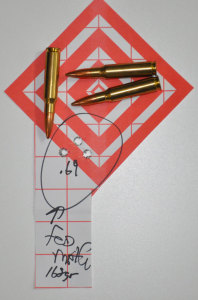 Using the Ruger scope rings included with the rifle I mounted a Burris 3-9 compact scope in the conventional position on the receiver and headed to the range. Shooting from the bench at 100 yards I was rewarded with numerous 3 shot groups in the 1” range or less. My best groups were with 168 grain Federal Match at .69” and Hornady Match ammunition at .68”. Everything was going fine until I started missing the paper altogether because the scope bases had loosened and the scope was practically falling off the rifle. Tightening the bases didn’t help, as they soon shot loose again. The lesson here is that I should have used thread locker on the bolts when I mounted the scope. I didn’t because I intended to remove it after the range session and it came back to bite me.
Using the Ruger scope rings included with the rifle I mounted a Burris 3-9 compact scope in the conventional position on the receiver and headed to the range. Shooting from the bench at 100 yards I was rewarded with numerous 3 shot groups in the 1” range or less. My best groups were with 168 grain Federal Match at .69” and Hornady Match ammunition at .68”. Everything was going fine until I started missing the paper altogether because the scope bases had loosened and the scope was practically falling off the rifle. Tightening the bases didn’t help, as they soon shot loose again. The lesson here is that I should have used thread locker on the bolts when I mounted the scope. I didn’t because I intended to remove it after the range session and it came back to bite me.
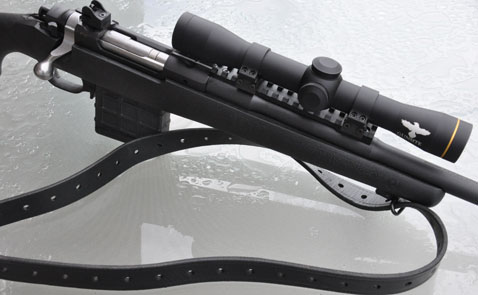 When I mounted the Leupold scout scope you can bet I didn’t neglect to properly secure the screws on the low Leupold PRW rings and the scope stayed put. I decided to shoot the rifle with the scout scope from prone off a Harris bipod and with a Rhodesian sling made by Andy’s Leather. This sling is a favorite of mine, as it gives me the advantages of a three point sling – I use the front loop to sling up – while retaining the convenience of a carry strap, all without the need to install a third sling swivel. I wanted to zero the rifle at 200 yards so I started by shooting on paper at 25 yards then refined the zero shooting on steel at 100 and 200 yards. To my considerable delight I fired a 3 shot group at 100 yards that went into an inch and a group at 200 that printed into 2.5 inches. Any way you look at it, that kind of accuracy proves this rifle is a shooter. With its light weight and the low powered scope the rifle is a joy for making quick snap shots. It’s easy to carry and satisfies all the criteria we were after when we designed the rifle to be an affordable, accurate, general-purpose rifle. I like it a lot.
When I mounted the Leupold scout scope you can bet I didn’t neglect to properly secure the screws on the low Leupold PRW rings and the scope stayed put. I decided to shoot the rifle with the scout scope from prone off a Harris bipod and with a Rhodesian sling made by Andy’s Leather. This sling is a favorite of mine, as it gives me the advantages of a three point sling – I use the front loop to sling up – while retaining the convenience of a carry strap, all without the need to install a third sling swivel. I wanted to zero the rifle at 200 yards so I started by shooting on paper at 25 yards then refined the zero shooting on steel at 100 and 200 yards. To my considerable delight I fired a 3 shot group at 100 yards that went into an inch and a group at 200 that printed into 2.5 inches. Any way you look at it, that kind of accuracy proves this rifle is a shooter. With its light weight and the low powered scope the rifle is a joy for making quick snap shots. It’s easy to carry and satisfies all the criteria we were after when we designed the rifle to be an affordable, accurate, general-purpose rifle. I like it a lot.
The Scout Concept
For those of you who are interested in Jeff Cooper’s scout rifle idea, how it came together in the Steyr Scout rifle, and how this new Ruger stacks up to the ideal, please read on. If worrying about concepts developed in the early 1980s doesn’t do much for you, then you might want to tune out.
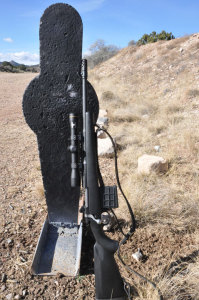 Cooper felt the scout rifle was the ideal general-purpose tool for a lone person – a scout – who would need to move quickly with a short, handy, powerful rifle suitable for fighting or hunting. After examining semi-automatic rifles Cooper felt they were too heavy and complex to satisfy his criteria, and, he felt the need for rapid fire was not nearly as important as the ability to get fast, first round hits. He specified an overall length of less than one meter (39 inches), a maximum weight, unloaded, with scope attached of 3 kilos (6.6 pounds) and the ability to carry extra ammunition on the rifle, up to a capacity of 10 rounds. He suggested a Mauser action with controlled feed and extraction might be best and that a round, smooth bolt handle was desirable (these traits are present in the Ruger but not in the original Steyr). He thought a built in bipod, or the ability to easily attach one was a good, but not necessary idea and he felt the rifle should have iron sights as a back up to the telescope. Early on Cooper suggested a loop sling he called the CW sling, but later he became enthused with the 3 point sling invented by Gunsite instructor Eric Ching. Of course, the low powered, forward mounted telescope as later made by Leupold and Burris was considered to be central to the whole concept.
Cooper felt the scout rifle was the ideal general-purpose tool for a lone person – a scout – who would need to move quickly with a short, handy, powerful rifle suitable for fighting or hunting. After examining semi-automatic rifles Cooper felt they were too heavy and complex to satisfy his criteria, and, he felt the need for rapid fire was not nearly as important as the ability to get fast, first round hits. He specified an overall length of less than one meter (39 inches), a maximum weight, unloaded, with scope attached of 3 kilos (6.6 pounds) and the ability to carry extra ammunition on the rifle, up to a capacity of 10 rounds. He suggested a Mauser action with controlled feed and extraction might be best and that a round, smooth bolt handle was desirable (these traits are present in the Ruger but not in the original Steyr). He thought a built in bipod, or the ability to easily attach one was a good, but not necessary idea and he felt the rifle should have iron sights as a back up to the telescope. Early on Cooper suggested a loop sling he called the CW sling, but later he became enthused with the 3 point sling invented by Gunsite instructor Eric Ching. Of course, the low powered, forward mounted telescope as later made by Leupold and Burris was considered to be central to the whole concept.
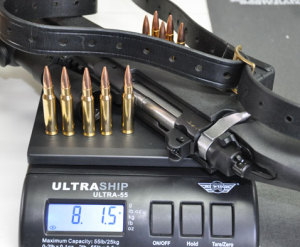 I weighed and measured my Steyr Scout rifle with Leupold scout scope and compared it to the Ruger synthetic GSR. For the purposes of this evaluation I removed the muzzle brake from the Ruger and screwed on the thread protector, as the Steyr has an unthreaded barrel and no provision for attaching brakes or suppressors. The Steyr comes with two plastic 5 round magazines. The Ruger comes with a single, 10 round metal magazine; 3, 5 and 10 round plastic magazines are available from Ruger (I used a 10 round plastic magazine for this comparison). Here’s what I came up with:
I weighed and measured my Steyr Scout rifle with Leupold scout scope and compared it to the Ruger synthetic GSR. For the purposes of this evaluation I removed the muzzle brake from the Ruger and screwed on the thread protector, as the Steyr has an unthreaded barrel and no provision for attaching brakes or suppressors. The Steyr comes with two plastic 5 round magazines. The Ruger comes with a single, 10 round metal magazine; 3, 5 and 10 round plastic magazines are available from Ruger (I used a 10 round plastic magazine for this comparison). Here’s what I came up with:
| Ruger GSR | Steyr Scout | |
| Overall length (no stock spacers): | 35.25” | 39” |
| Capacity: | 3,5 or 10 rds. | 5 rds. 2 ea. |
| Sights: | ghost ring | ghost ring |
| Weight, bare with scope: | 6 lbs, 13.5 ozs | 6 lbs, 14.5 ozs |
| Weight, with scope, sling, magazine(s) and 10 rounds of 168gr. ammunition |
8 lbs, 1.5 ozs | 8 lbs, 4 ozs |
To my mind, the Ruger GSR, and especially the lightweight GSR synthetic meets Jeff Cooper’s idealized criteria for the scout rifle, but more importantly, the GSR is an excellent, versatile general-purpose rifle for the modern shooter.
For more information:
About the Author:  Ed Head is a regular on Shooting Gallery, Gun Stories and Down Range TV. He has worked for almost 30 years in law enforcement, first in the United States Air Force and then with the United States Border Patrol, retiring as a Field Operations Supervisor. During his Border Patrol career, Ed worked in a variety of patrol, investigative and training capacities. Ed has an extensive background as a firearms instructor, having trained thousands, ranging from beginners to police, military and special operations personnel. Having taught at Gunsite for 20 years, Ed first trained there under the world famous shooting school’s founder, Jeff Cooper, then later ran the school as the operations manager for more than five years. Ed lives in Chino Valley, Arizona, where he continues to teach and write.
Ed Head is a regular on Shooting Gallery, Gun Stories and Down Range TV. He has worked for almost 30 years in law enforcement, first in the United States Air Force and then with the United States Border Patrol, retiring as a Field Operations Supervisor. During his Border Patrol career, Ed worked in a variety of patrol, investigative and training capacities. Ed has an extensive background as a firearms instructor, having trained thousands, ranging from beginners to police, military and special operations personnel. Having taught at Gunsite for 20 years, Ed first trained there under the world famous shooting school’s founder, Jeff Cooper, then later ran the school as the operations manager for more than five years. Ed lives in Chino Valley, Arizona, where he continues to teach and write.

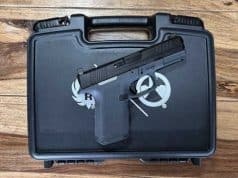
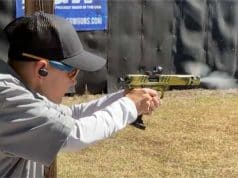
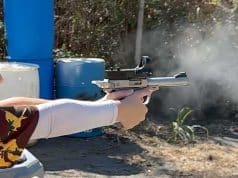
Thanks for the good words on my slings Ed!
Yes, please!
Would like to purchase a composite stock and the featured brake so I may continue to use my 16.5″ RGS.
The news of this new configuration is terrific!
Thanks, Ruger!
I will take the opportunity to give cudos to Andy’s slings. I own one Galco “ching” type sling, and it is an ok product, but compared to Andy’s not even close, especially considering they are sixes on the dollar side.
I am also glad to see Ruger come out (finally) with a syn stock for this rifle. I’m sorry, but that laminated monster was a show stopper from the get go for me. Now, if they would ship the rifle with a decent flash protector instead of a worthless, ear destroying brake.
My Rem 600 “Scout” sits in a High Tech stock, This rifle, scoped with Burris Scout scope, buis, slinged, butt cuff with 6 rds, and 4 in the mag comes in at exactly 7 lbs total, and it is a pleasure to shoot. Recoil is managed with good stock configuration,there is no, nada, zip, zilch need for a brake on a 7 lb .308
Ruger has done a lot right on this rifle, but it could be better IMHO.
I called and asked them about the stock. They said the only way for us to get one is to buy the gun that fits in it. There is no way to get for a replacement, it has to be a new purchase. Basically if anything you like for the scout. You have to buy the model that has it.